![]()

If the vertex is of the Bezier or Bezier Corner type, you can also move and rotate handles, thus affecting the shapes of any segments joined at the vertex. You can copy and paste the handles between vertices using tangent copy/paste. You can reset them or switch between types using the quad menu. The tangent types are always available on the quad menu when a vertex is selected; your cursor doesn't have to be directly over them in the viewport.
Procedures
To set a vertex type:
- Right-click any vertex in a selection.
- Choose a type from the shortcut menu. Each vertex in a shape can be one of four types:
- Smooth: Nonadjustable vertices that create smooth continuous curves. The curvature at a smooth vertex is determined by the spacing of adjacent vertices.
- Corner: Nonadjustable vertices that create sharp corners.
- Bezier: Adjustable vertex with locked continuous tangent handles that create a smooth curve. The curvature at the vertex is set by the direction and magnitude of the tangent handles.
- Bezier Corner:
Adjustable vertex with discontinuous tangent handles that create a sharp corner. The curvature of the segment as it leaves the corner is set by the direction and magnitude of the tangent handles.
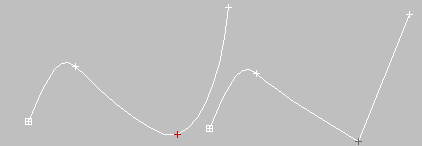
Smooth vertex (left) and Corner vertex (right)
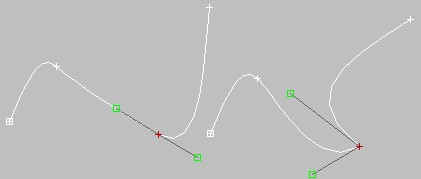
To copy and paste vertex tangent handles:
- Turn on
 (Vertex), then
(Vertex), then
 select the vertex you want to copy from.
select the vertex you want to copy from.
- On the Geometry rollout scroll down to the Tangent group and click Copy.
- Move your cursor over the vertices in the viewport. The cursor changes to a copy cursor. Click the handle you wish to copy.
- On the Geometry rollout scroll down to the Tangent group and click Paste.
- Move your cursor over the vertices in the viewport. The cursor changes to a paste cursor. Click the handle you wish to paste to.
The vertex tangency changes in the viewport.
To reset vertex handle tangency:
- Select the vertex that is problematic.
- Right-click and choose Reset Tangents.
Any vertex handle editing you have done is discarded and the handles are reset.
It is easy to make the handles very small and coincident with the vertex, which makes them hard to select and edit. Reset the vertex handle tangency to redraw your handles
To extrude a vertex
- Select the vertex or vertices you want to extend with the Move, Rotate, or Scale tools.
- Shift + LMB drag.
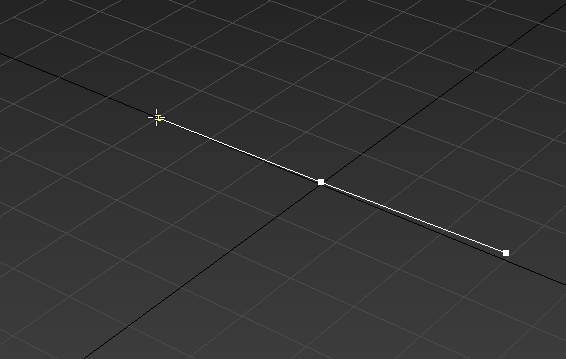

Interface
Soft Selection rollout
For information on the Soft Selection rollout settings, see Soft Selection Rollout.
Geometry rollout
New Vertex Type group

The radio buttons in this group let you determine the tangency of the new vertices created when you Shift+Clone segments or splines. If you later use Connect Copy, vertices on the splines that connect the original segment or spline to the new one will have the type specified in this group.
This setting has no effect on the tangency of vertices created using tools such as the Create Line button, Refine, and so on.
- Linear New vertices will have linear tangency.
- Smooth New vertices will have smooth tangency.
When this option is chosen, new vertices that overlap are automatically welded.
- Bezier New vertices will have bezier tangency.
- Bezier Corner New vertices will have bezier corner tangency.

- Create Line
- Adds more splines to the selected object. These lines are separate spline sub-objects; create them in the same way as the line spline. To exit line creation, right-click or click to turn off Create Line.
- Break
- Splits a spline at the selected vertex or vertices. Select one or more vertices and then click Break to create the split. There are now two superimposed non-connected vertices for every previous one, allowing the once-joined segment ends to be moved away from each other.
- Attach
- Attaches another spline in the scene to the selected spline. Click the object you want to attach to the currently selected spline object. The object you're attaching must also be a spline.
For further details, see Attach.
- Attach Mult.
- Click this button to display the Attach Multiple dialog, which contains a list of all other shapes in the scene. Select the shapes you want to attach to the current editable spline, then click OK.
- Reorient When on, reorients attached splines so that each spline's creation local coordinate system is aligned with the creation local coordinate system of the selected spline.
- Cross Section
- Creates a spline cage out of cross-sectional shapes. Click Cross Section, select one shape then a second shape, splines are created joining the first shape with the second. Continue clicking shapes to add them to the cage. This functionality is similar to the Cross Section modifier, but here you can determine the order of the cross sections. Spline cage tangency can be defined by choosing Linear, Bezier, Bezier Corner or Smooth in New Vertex Type group.
Tip: When you edit the spline cage, use Area Selection before selecting your vertices. This will keep their positions together as you transform them.
[Refine group]

The Refine group includes a number of functions useful for building spline networks for use with the Surface modifier.
- Refine
- Lets you add vertices without altering the curvature values of the spline. Click Refine, and then select any number of spline segments to add a vertex each time you click (the mouse cursor changes to a "connect" symbol when over an eligible segment). To finish adding vertices, click Refine again, or right-click in the viewport.
You can also click existing vertices during a refine operation, in which case 3ds Max displays a dialog asking if you want to Refine or Connect Only to the vertex. If you choose Connect Only, 3ds Max will not create a vertex: it simply connects to the existing vertex.
The Refine operation creates a different type of vertex depending on the types of vertices on the endpoints of the segment being refined.
- If the bordering vertices are both Smooth types, the Refine operation creates a Smooth type vertex.
- If the bordering vertices are both Corner types, the Refine operation creates a Corner type vertex.
- If either of the bordering vertices is a Corner or Bezier Corner, the Refine operation creates a Bezier Corner type.
- Otherwise, the operation creates a Bezier type vertex.
- Connect
- When on, creates a new spline sub-object by connecting the new vertices. When you finish adding vertices with Refine, Connect makes a separate copy of each new vertex and then connects all of the copies with a new spline.
Note: For Connect to work, you must turn it on before you click Refine.
After turning on Connect and before beginning the refinement process, turn on any combination of these options:
- Linear When on, makes all segments in the new spline straight lines by using Corner vertices. When Linear is off, the vertices used to create the new spline are of the Smooth type.
- Bind First Causes the first vertex created in a refinement operation to be bound to the center of the selected segment. See Bound Vertex.
- Closed When on, connects the first and last vertices in the new spline to create a closed spline. When Closed is off, Connect always creates an open spline.
- Bind Last Causes the last vertex created in a refinement operation to be bound to the center of the selected segment. See Bound Vertex.
End Point Auto-Welding group

- Automatic Welding
- When Automatic Welding is turned on, an end point vertex that is placed or moved within the threshold distance of another end point of the same spline is automatically welded. This feature is available at the object and all sub-object levels.
- Threshold
- The threshold distance spinner is a proximity setting that controls how close vertices can be to one another before they are automatically welded. Default=6.0.
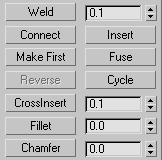
- Weld
- Converts two end vertices, or two adjacent vertices within the same spline, into a single vertex. Move either two end vertices or two adjacent vertices near each other, select both vertices, and then click Weld. If the vertices are within the unit distance set by the Weld Threshold spinner (to the right of the button), they're converted into a single vertex. You can weld a selection set of vertices, as long as each pair of vertices is within the threshold.
- Connect
- Connects any two end vertices, resulting in a linear segment, regardless of the tangent values of the end vertices. Click the Connect button, point the mouse over an end vertex until the cursor changes to a cross, and then drag from one end vertex to another end vertex.
- Insert
- Inserts one or more vertices, creating additional segments. Click anywhere in a segment to insert a vertex and attach the mouse to the spline. Then optionally move the mouse and click to place the new vertex. Continue moving the mouse and clicking to add vertices. A single click inserts a corner vertex, while a drag creates a Bezier (smooth) vertex.
Right-click to complete the operation and release the mouse. At this point, you're still in Insert mode, and can begin inserting vertices in a different segment. Otherwise, right-click again or click Insert to exit Insert mode.
- Make First
- Specifies which vertex in the selected shape is the first vertex. The first vertex of a spline is indicated as a vertex with a small box around it. Select one vertex on each spline within the currently edited shape that you want to change and click the Make First button.
On open splines, the first vertex must be the endpoint that is not already the first vertex. On closed splines, it can be any point that isn't already the first vertex. Click the Make First button, and the first vertices will be set.
The first vertex on a spline has special significance. The following table defines how the first vertex is used.
Shape Use First Vertex Meaning Loft Path Start of the path. Level 0. Loft Shape Initial skin alignment. Path Constraint Start of the motion path. 0% location on the path. Trajectory First position key. - Fuse
- Moves all selected vertices to their averaged center.
Fuse is useful for making vertices coincide when building a spline network for use with the Surface modifier.
Note: Fuse doesn't join the vertices; it simply moves them to the same location.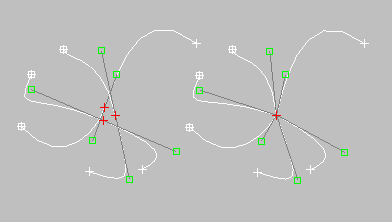
Three selected vertices (left); fused vertices (right)
- Cycle
- Selects successive coincident vertices. Select one of two or more vertices that share the exact same location in 3D space, and then click Cycle repeatedly until the vertex you want is selected.
Cycle is useful for selecting a specific vertex from a group of coincident vertices at a spline intersection when building a spline network for use with the Surface modifier.
Tip: Watch the info display at the bottom of the Selection rollout to see which vertex is selected. - CrossInsert
- Adds vertices at the intersection of two splines belonging to the same spline object. Click CrossInsert, and then click the point of intersection between the two splines. If the distance between the splines is within the unit distance set by the CrossInsert Threshold spinner (to the right of the button), the vertices are added to both splines.
You can continue using CrossInsert by clicking different spline intersections. To finish, right-click in the active viewport or click the CrossInsert button again.
CrossInsert is useful for creating vertices at spline intersections when building a spline network for use with the Surface modifier.
Note: CrossInsert doesn't join the two splines, but simply adds vertices where they cross. - Fillet
- Lets you round corners where segments meet, adding new control vertices. You can apply this effect interactively (by dragging vertices) or numerically (using the Fillet spinner). Click the Fillet button, and then drag vertices in the active object. The Fillet spinner updates to indicate the fillet amount as you drag.
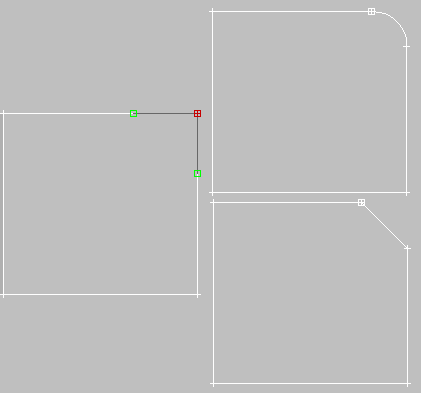
Original rectangle (left), after applying Fillet (top right), and after applying Chamfer (bottom right)
If you drag one or more selected vertices, all selected vertices are filleted identically. If you drag an unselected vertex, any selected vertices are first deselected.
You can continue using Fillet by dragging on different vertices. To finish, right-click in an active viewport or click the Fillet button again.
A fillet creates a new segment connecting new points on both segments leading to the original vertex. These new points are exactly <fillet amount> distance from the original vertex along both segments. New fillet segments are created with the material ID of one of the neighboring segments (picked at random).
For example, if you fillet one corner of a rectangle, the single corner vertex is replaced by two vertices moving along the two segments that lead to the corner, and a new rounded segment is created at the corner.
Note: Unlike the Fillet/Chamfer modifier, you can apply the Fillet function to any type of vertex, not just Corner and Bezier Corner vertices. Similarly, adjoining segments need not be linear.- Fillet Amount Adjust this spinner (to the right of the Fillet button) to apply a fillet effect to selected vertices.
- Chamfer
- Lets you bevel shape corners using a chamfer function. You can apply this effect interactively (by dragging vertices) or numerically (using the Chamfer spinner). Click the Chamfer button, and then drag vertices in the active object. The Chamfer spinner updates to indicate the chamfer amount as you drag.
If you drag one or more selected vertices, all selected vertices are chamfered identically. If you drag an unselected vertex, any selected vertices are first deselected.
You can continue using Chamfer by dragging on different vertices. To finish, right-click in an active viewport or click the Chamfer button again.
A chamfer "chops off" the selected vertices, creating a new segment connecting new points on both segments leading to the original vertex. These new points are exactly <chamfer amount> distance from the original vertex along both segments. New chamfer segments are created with the material ID of one of the neighboring segments (picked at random).
For example, if you chamfer one corner of a rectangle, the single corner vertex is replaced by two vertices moving along the two segments that lead to the corner, and a new segment is created at the corner.
Note: Unlike the Fillet/Chamfer modifier, you can apply the Chamfer function to any type of vertex, not just Corner and Bezier Corner vertices. Similarly, adjoining segments need not be linear.- Chamfer Amount Adjust this spinner (to the right of the Chamfer button) to apply a chamfer effect to selected vertices.
Tangent group

Tools in this group let you copy and paste vertex handles from one vertex to another.
- Copy
- Turn this on, then choose a handle. This action copies the selected handle tangent into a buffer.
- Paste
- Turn this on, then click a handle. This pastes the handle tangent onto the selected vertex.
- Paste Length
- When this is on, the handle length is also copied. When this is off, only the handle angle is considered, the handle length is unchanged.

- Hide
- Hides selected vertices and any connected segments. Select one or more vertices, and then click Hide.
- Unhide All
- Displays any hidden sub-objects.
- Bind
- Lets you create
bound vertices. Click Bind, and then drag from any end vertex in the current selection to any segment in the current selection except the one connected to the vertex. Before dragging, when the cursor is over an eligible vertex, it changes to a + cursor. While dragging, a dashed line connects the vertex and the current mouse position, and when the mouse cursor is over an eligible segment, it changes to a "connect" symbol. When you release over an eligible segment, the vertex jumps to the center of the segment and is bound to it.
Bind is useful for connecting splines when building a spline network for use with the Surface modifier.
- Unbind
- Lets you disconnect bound vertices from the segments to which they're attached. Select one or more bound vertices, and the click the Unbind button.
- Delete
- Deletes the selected vertex or vertices, along with one attached segment per deleted vertex.
Display group
- Show selected segs
- When on, any selected segments are highlighted in red at the Vertex sub-object level. When off (the default), selected segments are highlighted only at the Segment sub-object level.
This feature is useful for comparing complex curves against each other.